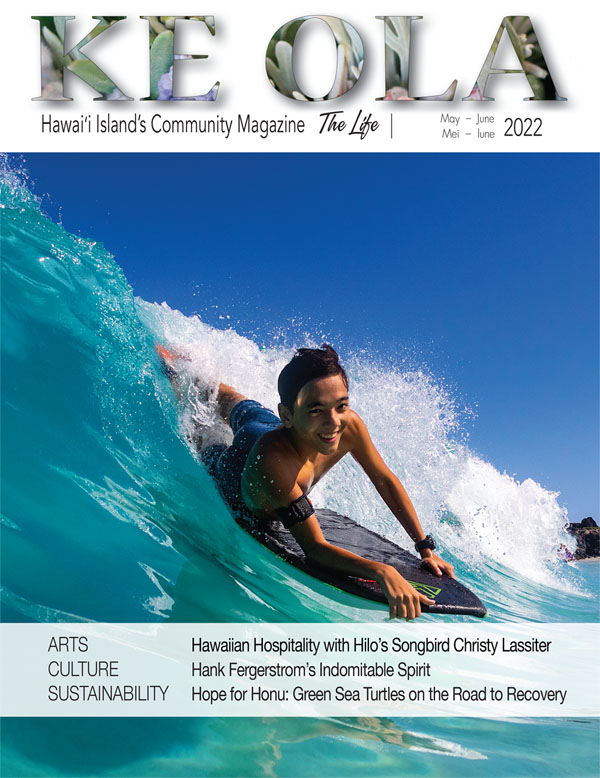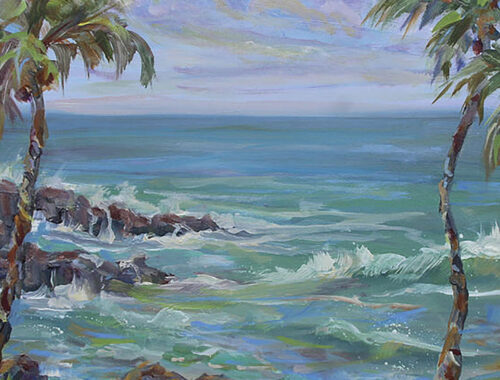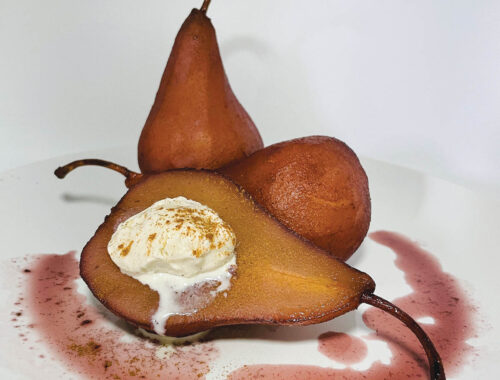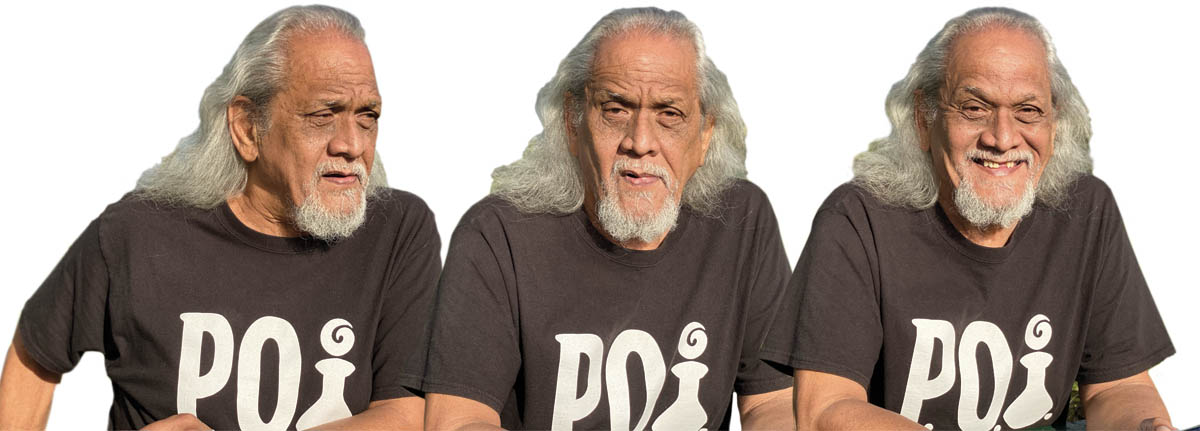
Hank Fergerstrom’s Indomitable Spirit

By Ana Kahoopii and Tanya Yamanaka
Unko Hank sits at an empty picnic table near the King Kamehameha statue on Hilo’s bayfront, the sun shining on this Valentine’s Day morn. The gold bodice of Kamehameha glitters behind him; the King’s outstretched arms seemingly mimic the feeling Hank beckons to us: Come! Come and listen.
Hawai‘i was a territory of the United States when Hanalei “Hank” Fergerstrom was born in 1949, near the birthplace of Kamehameha at North Kohala Hospital. His mother, Charmine, and father, Harry, divorced after his younger brother Samuel was born. His mother remarried twice, moving to California and O‘ahu. Raised in a military atmosphere, Hank was sent from Pearl Harbor military base to Hawai‘i Island at age 12 to have his father “straighten him out.”
Hank’s first court appearance was when he was only 11 years old. He and his brothers had gotten in trouble on a military base, playing in an off-limits warehouse. The judge interrogated the boys to ensure they knew what they had done wrong. His mother had instructed them to answer respectfully and apologize. Still, when the judge came to him, Hank responded that he had a deal to deliver newspapers in exchange for the rights to play in the Pearl Harbor warehouse. Even then, Hank’s penchant for truth was a guiding force that led to more punishment, sometimes more severe than if he had said nothing at all.

Law of the Splintered Paddle

Hank’s early years didn’t break his spirit; they emboldened him. His many years in and out of the justice system gave him legal experience and know-how that couldn’t be learned through books or school.
During those years, Hank’s guiding principle was Māmalahoe Kānāwai (The Law of the Splintered Paddle). The law was enacted in 1797 before Kamehameha unified the Hawaiian Islands and remains the law today, as Article 9, Section 10 of the Hawai‘i State Constitution. Māmalahoe Kānāwai protects the vulnerable during times of conflict. This would apply to his personal life, as well as being a single parent of a disabled child. Hank’s son, Michael Keali‘i lawe mai iao eloko i kapo (the king who brings light into darkness) was born on August 26, 1979. Hank credits his son with keeping him focused on his kuleana (responsibility).
Hank’s adherence to Māmalahoe Kānāwai led him to become an early member of Na Koa. “Na Koa O Pu‘ukohola are the warriors from the mound of the whale [at the heiau in North Kohala]. The restoration of Na Koa was the first time in 200 years the warriors of Kamehameha the Great had assembled,” says Hank. The Na Koa warriors were a perfect fit for Hank with their guiding principles of protecting the land, resources, and people. Hank took the kuleana to serve and protect seriously. It is Hank’s commitment to this kuleana that shaped his decades of activism.
Hank is best known for his annual vigils held at ‘Iolani Palace. Conducted on the palace grounds since 2000, these four-day vigils held at the Hawaiian nation’s power center commemorate two critical historical events: Lā ho‘iho‘i Ea (Sovereignty Restoration Day) in July, and the illegal overthrow of the Hawaiian Kingdom on January 16. Hank offers an open invitation to come and join him, saying to the crowd in front of the palace, “There is no question that the need for true unity is of the utmost importance, especially with all the hewa [wrongs] surrounding us—Mauna Kea, Haleakalā, Ho‘opili, Kualoa, Pōhakuloa, rail, military build-up. We have to put our heads together and bring all of these things to a head by chopping the legs they stand on. No annexation. No treaty. No land deeds. No kuleana. Let’s explore the many ways we can prepare to act in unison and how each island can support the others. This is the time!” The vigils are an opportunity for the community to attend workshops, share mana‘o (ideas), and raise awareness. When Hank isn’t preparing for the Palace vigils, he is intensely involved in protecting Mauna Kea. Hank was first introduced to the beauty of Mauna Kea by his father, who was a rancher in the area. Later he would become a practitioner of the Temple of Lono, leading him to spend days and sometimes weeks in solitude on the mauna. He was one of many kūpuna (elders) assembled on the Hawaiian Homeland’s Mauna Kea access road from July, 2019, until the moratorium in December, 2019.
Perfect Timing for Pu‘uhonua
The late morning sun becomes overcast with shadows as Hank begins to talk about his healing journey. He speaks with great tenderness recalling the loss of his only child in 2017 and his recent diagnosis of lung cancer in 2021. Cancer hasn’t slowed Hank down in the least. His mind is as sharp as ever; his enthusiasm to explore healing modalities and to find meaning from this experience dominated his consciousness. While working with traditional medical treatment, Hank also studied alternative therapies and was treated by some profoundly gifted local healers and practitioners. Although the cancer in Hank’s lung has grown in size, he is feeling better than he has in many years. This is due to the support of many friends that have made the exploration of alternative treatment possible.
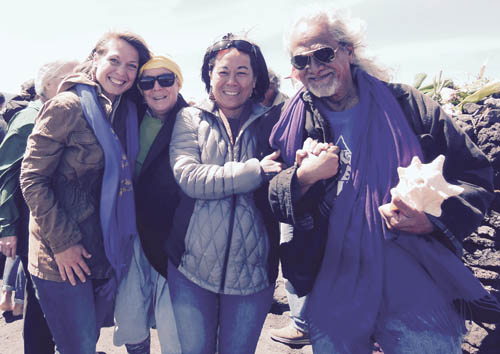
Hank’s indomitable spirit pushes him to find the light of a situation. The gift of his grief at losing his son and his illness was the vision Hank received in 2021 of a healing pu‘uhonua, a sanctuary, a place imbued with mystical power, a place of forgiveness. Hank’s vision showed him a healing pu‘uhonua that was not a select place or building, but the entire moku (island). Hank says, “We probably have more healers per square foot than any other place on Earth. Our island is a place of healing, and our people, malihini [newcomers] and locals alike, are magical.”
“It is perfect timing,” Hank continues. “We had just learned our lesson regarding our dependence on tourism following the pandemic. We also had the unexpected gift of witnessing the ocean, the forests, and wildlife benefit from an unencumbered space. Why aren’t we utilizing the mana and magic of our island and people by becoming a pu‘uhonua for the world? A place of healing, spiritual renewal, and restoration?” Hank asks aloud, into the sky. Hank elaborates that this restoration includes Hawai‘i Island being a place of agriculture as a part of healing the body and spirit, and that this is true hospitality.
“Aloha is the foundation of our culture. Although that word is overused it has deep meaning and significance. Living aloha is healing. On the surface, aloha denotes a simple greeting; however, it also includes the deeper aspects of our cultural values, sharing, kindness, respect, tenderness.” Hank’s voice trails off softly, as his eyes are directed toward a kōlea (Pacific golden plover) flying overhead, offering a short silence to take in the wisdom shared. As the kōlea lands in the grass beside him, Hank continues, “Many Hawaiian cultural practices such as ho‘oponopono and lomilomi are specifically geared to maintain balance and a stable sense of health and wellbeing. Rather than being an undefined tourist destination, it is time to define who we are, what we are about, and what we have to offer our global family.”
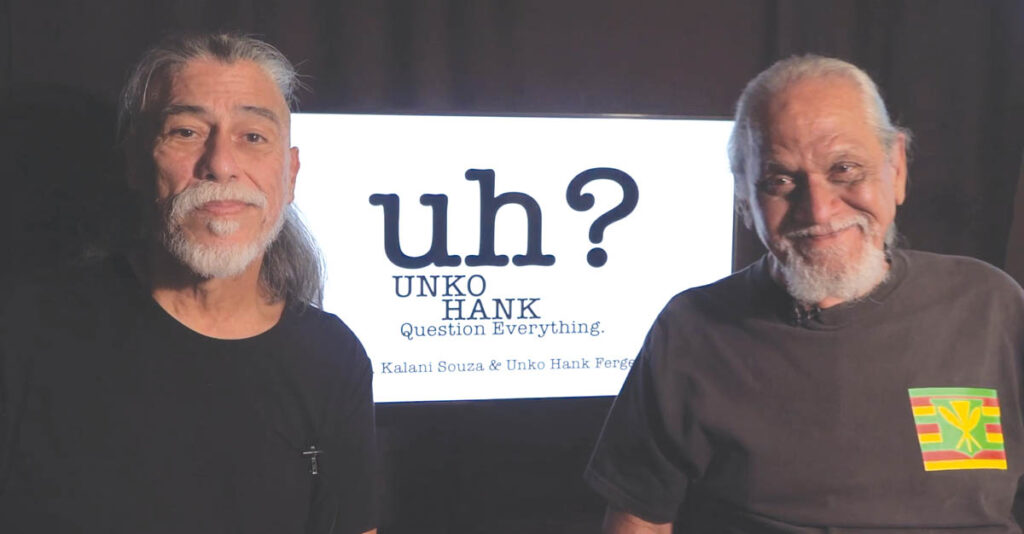
Ready for Everything
When asked what he’s up to now, Hank’s eyes light up. He taps on the computer he pulls out of his bag. “This,” he says, as he sets his iMac on the rustic picnic table. In 2021, Hank teamed up with Rev. M. Kalani Souza to present Unko Hank Question Everything, short videos of Kalani and Hank discussing long-time issues like Red Hill and newer events like Russia’s invasion of Ukraine. Their lively and animated conversation usually starts with a pointed observation or question and aims to be thought-provoking and insightful. Unko Hank asks us to question everything, diving deep to explore the narratives we play in our own minds. In defining who we are, individually as well as collectively, we often start with foundational assumptions that we aren’t always aware of because we’ve held them for so long. “Stay tuned, there is so much ahead. We need everyone involved to turn our moku into a pu‘uhonua. The best is yet to come. Kalani and I will be bringing it!” Hank’s enthusiasm is infectious, and he is clearly ready for whatever’s next.
The Healing Journey Continues
Hank’s healing journey continues and is a testament to living with courage, passion, and authenticity. It encompasses a sense of wholeness integrated with the sacred which cycles back, and is expressed in physical healing. Hank’s medicine is a personal relationship with the gods, strengthened with culture and ceremony along with an indestructible passionate connection to the ‘āina (land). He has found his own unique way of overcoming segregation, violence, trauma, and grief and has taken his well-earned place as one of Hawai‘i’s most cherished kupuna. ❖
Māmalahoe Kānāwai, 1797
E nā kānaka, E mālama ‘oukou i ke akua A e mālama ho‘i ke kanaka nui a me kanaka iki; E hele ka ‘elemakule, ka luahine, a me ke kama A moe i ke ala ‘A‘ohe mea nāna e ho‘opilikia. Hewa nō, make.
Law of the Splintered Paddle
Oh people, Honor thy god; respect alike [the rights of] people both great and humble; May everyone, from the old men and women to the children be free to go forth and lie in the road without fear of harm. Break this law, and die.
For more information: http://olohana.org/index.php/uh-unko-hank-question-everything/
